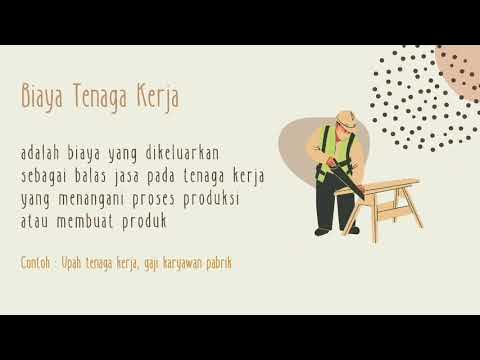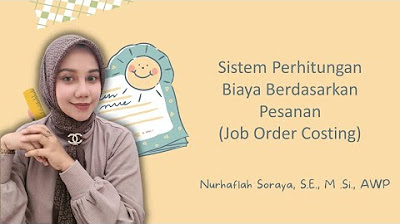Akuntansi untuk Tenaga Kerja part 1
Summary
TLDRThis video delves into production costs, emphasizing the significance of direct labor in manufacturing. It explains the three main components of production costs: direct materials, direct labor, and overhead costs. The discussion highlights how to categorize and account for direct labor expenses, distinguishing between direct and indirect labor. Through practical examples, including wage calculations for regular and overtime hours, the video illustrates the importance of accurate financial reporting. This knowledge is crucial for effective budgeting and understanding labor-related expenses within a manufacturing context.
Takeaways
- 😀 Direct labor costs are defined as the expenses related to the physical and mental efforts of employees directly involved in production.
- 😀 Understanding the different departments involved in direct labor, such as human resources and payroll, is crucial for effective cost management.
- 😀 Labor is categorized into direct labor, which directly affects production, and indirect labor, which supports production indirectly.
- 😀 Direct labor costs are included in the cost of goods sold (COGS) on the income statement, impacting profitability analysis.
- 😀 Accurate calculation of direct labor costs requires distinguishing between regular pay and overtime pay for employees.
- 😀 Examples illustrate how to compute total wages by considering regular hours and any overtime worked.
- 😀 Journal entries related to direct labor costs must reflect when costs are incurred and allocated correctly between direct and indirect labor.
- 😀 Understanding labor costs is essential for creating accurate financial reports and assessing production efficiency.
- 😀 The session emphasizes the importance of analyzing labor costs to make informed decisions regarding pricing and budgeting.
- 😀 Students are encouraged to critically evaluate transactions related to labor costs to enhance their accounting skills.
Q & A
What are the three main components of production costs?
-The three main components of production costs are direct materials, direct labor, and overhead costs.
How is direct labor defined in the context of production accounting?
-Direct labor refers to the physical and mental efforts of employees who are directly involved in the production of goods.
What is the difference between direct labor and indirect labor?
-Direct labor consists of workers who directly contribute to the production process, while indirect labor includes those who support the process but do not engage directly in production, such as supervisors.
How are labor costs recorded in financial statements?
-Labor costs are recorded in the income statement under cost of goods sold (COGS) and operating expenses, depending on whether the labor is direct or indirect.
What is the significance of understanding direct labor costs?
-Understanding direct labor costs is crucial for accurately calculating total production costs and for effective financial reporting and management.
What factors differentiate wages from salaries?
-Wages are typically associated with hourly work or physical labor, while salaries are usually linked to fixed payments for mental or managerial roles.
How do you calculate total direct labor costs for a worker who has regular and overtime hours?
-Total direct labor costs can be calculated by summing the regular pay for hours worked and the additional pay for any overtime hours at the designated overtime rate.
What example is provided in the video for calculating labor costs?
-The video provides an example where an employee works 40 regular hours and 5 overtime hours, illustrating how to calculate total compensation based on different pay rates.
What journal entries are involved in recording direct labor costs?
-Journal entries for direct labor costs typically include debiting the labor expense accounts and crediting cash or liabilities for amounts owed.
What are the implications of misclassifying labor costs in accounting?
-Misclassifying labor costs can lead to inaccurate financial reporting, affecting profitability assessments and decision-making processes.
Outlines

Cette section est réservée aux utilisateurs payants. Améliorez votre compte pour accéder à cette section.
Améliorer maintenantMindmap

Cette section est réservée aux utilisateurs payants. Améliorez votre compte pour accéder à cette section.
Améliorer maintenantKeywords

Cette section est réservée aux utilisateurs payants. Améliorez votre compte pour accéder à cette section.
Améliorer maintenantHighlights

Cette section est réservée aux utilisateurs payants. Améliorez votre compte pour accéder à cette section.
Améliorer maintenantTranscripts

Cette section est réservée aux utilisateurs payants. Améliorez votre compte pour accéder à cette section.
Améliorer maintenantVoir Plus de Vidéos Connexes

(FACIL) Materiales Directos, Mano de Obra Directa, Costos Indirectos de Fábrica

MENGHITUNG BIAYA PRODUKSI

Biaya Produksi | Biaya Non Produksi | Menganalisis Biaya Prototype Produk Barang/Jasa

Menghitung Harga Pokok Produksi - Part 1

UNDERSTAND MANUFACTURING ACCOUNTS WITHIN 10 MINUTES!!!

Job Order Costing | Metode Harga Pokok Pesanan | Akuntansi Biaya | Bahan Ajar Akuntansi Polmed
5.0 / 5 (0 votes)
